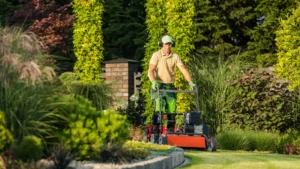A Comprehensive Guide of Large Tree Moving
Moving large trees from one location to another is a challenging but rewarding task. This process is often necessary when trees need to be relocated for landscaping, construction projects, or preservation purposes. Large tree moving requires careful planning, the right equipment, and expertise to ensure the tree’s survival and minimize stress during the transplanting process. If done correctly, it can significantly enhance the aesthetics and environmental benefits of your landscape, making the effort worthwhile.
In this article, we will discuss the step-by-step process of large tree moving, the equipment required, and the essential aftercare measures to ensure the tree thrives in its new location. We’ll also explore how to care for the tree after the move and the key considerations involved in maintaining the health and longevity of a transplanted tree.
Overview of Large Tree Moving
Relocating a large tree involves the careful excavation, transportation, and replanting of the tree in a new location. Unlike smaller plants, large trees have an extensive root system and require more intensive methods to move without causing damage. The process typically involves specialized equipment, including tree spades, cranes, and trucks, to handle the weight and size of the tree.
The key reasons for large tree moving include enhancing landscape design, preserving valuable or heritage trees, clearing land for construction, or rebalancing the ecosystem in urban areas. Successful tree relocation requires minimizing the stress on the tree and ensuring the roots, trunk, and canopy are protected throughout the process.
Before deciding to move a large tree, it’s important to assess the health of the tree, determine the right season for the move (typically during dormancy), and plan for the long-term care required to help the tree acclimate to its new environment. This ensures a higher chance of survival and growth after transplantation.
Step-by-Step Process of Large Tree Moving
1. Assessing the Tree’s Suitability for Moving
Before moving a large tree, it is essential to evaluate its health and determine whether it can withstand the relocation process. Factors such as the tree’s age, species, and root condition play a crucial role in its ability to survive. Consulting an arborist is highly recommended at this stage to inspect the tree and ensure it is healthy enough to be moved.
2. Choosing the Right Time for Transplanting
Timing is crucial when moving a large tree. The best time to transplant is during the tree’s dormancy period, typically in late fall or early spring, when the tree is not actively growing. During this time, the tree experiences less stress and is better able to recover after the move. Avoid transplanting during hot, dry seasons or when the tree is in full bloom.
3. Preparing the Tree for Moving
Before moving the tree, it is important to prepare it by pruning back any dead or diseased branches and cutting back a portion of the canopy to reduce stress. This process, called root pruning, involves carefully trimming the roots a few months prior to the move to encourage the growth of new feeder roots closer to the trunk.
- Root Pruning: Start by digging a trench around the tree’s root ball, making clean cuts on the outer roots. Allow the tree to adjust for several months before the actual move. This helps minimize the shock to the tree when it is relocated.
4. Digging the Tree and Root Ball
The next step is to dig around the tree and carefully excavate the root ball. The size of the root ball is critical for the tree’s survival—typically, the diameter of the root ball should be 10-12 times the diameter of the tree’s trunk. The depth of the root ball should be proportionate to its width.
- Step-by-Step Digging Process:
- Mark the perimeter of the root ball.
- Dig a trench around the perimeter, being cautious not to damage the roots.
- Slowly undercut the root ball while keeping as much soil intact as possible.
- Use burlap or plastic to wrap the root ball securely, preventing it from falling apart.
5. Transporting the Tree
Once the tree is excavated, it needs to be lifted and transported to the new location. Large trees often require heavy equipment, such as tree spades, cranes, and flatbed trucks, to move them safely.
- Tree Spade: A tree spade is a machine designed to dig, lift, and transplant large trees with minimal damage to the root system.
- Cranes and Trucks: For extremely large trees, cranes are used to lift the tree onto a truck for transportation. The tree is carefully secured to ensure it remains stable during the move.
6. Replanting the Tree
At the new location, the hole for the tree should be dug twice as wide as the root ball and just as deep. This allows the roots to spread out and establish themselves in the new soil.
- Place the tree in the hole carefully, ensuring it is upright and aligned properly.
- Remove the burlap or plastic wrapping from the root ball.
- Backfill the hole with native soil, pressing down gently to eliminate air pockets.
7. Watering and Staking the Tree
After replanting, water the tree thoroughly to help settle the soil and encourage root growth. Depending on the size and species of the tree, staking may be necessary to support the tree while it re-establishes its roots.
Equipment Required for Large Tree Moving
Moving a large tree requires specialized equipment, depending on the size and complexity of the project. Key equipment includes:
- Tree Spade: A machine used to dig and lift the tree, ensuring the root ball stays intact.
- Cranes: Used for lifting particularly large trees, especially when manual labor isn’t enough.
- Flatbed Trucks: Essential for transporting large trees to the new location.
- Burlap or Plastic Wrap: To secure the root ball during transportation.
- Shovels and Digging Tools: For preparing the root ball and trenching.
What to Do After Moving the Tree
Once the tree has been transplanted, it’s essential to follow several steps to ensure the tree’s successful adaptation to its new environment:
1. Watering
One of the most important post-transplant care steps is consistent watering. Newly transplanted trees need extra water to help re-establish their root systems. Water the tree deeply at least once a week, ensuring that the root ball and surrounding soil are moist but not waterlogged.
2. Mulching
Apply a layer of mulch around the base of the tree to retain moisture, regulate soil temperature, and reduce competition from weeds. Mulch should be spread evenly in a 3-4 inch layer, but avoid piling it directly against the tree trunk.
3. Pruning
Minimal pruning may be required after the move to remove any damaged branches. However, avoid excessive pruning, as this can stress the tree even more. Allow the tree to focus its energy on establishing new roots.
4. Fertilization
Avoid fertilizing the tree immediately after the move, as this can overwhelm the stressed tree. Wait until the tree begins to show signs of new growth, and then apply a balanced fertilizer if necessary.
5. Monitoring for Stress
Keep an eye on the tree for any signs of transplant shock, such as wilting leaves, yellowing foliage, or stunted growth. Providing adequate water and protection from extreme weather will help reduce stress and promote healthy recovery.
How to Care for the Tree After Large Tree Moving
Proper aftercare is essential to the tree’s survival and continued growth after it has been transplanted. The following are some tips for ensuring a successful transition:
- Water Regularly: Ensure the tree receives enough water, particularly during the first few months after moving.
- Inspect for Pests and Diseases: Check the tree regularly for signs of pests or diseases and treat them promptly.
- Mulch and Fertilize: Mulching helps retain moisture, while proper fertilization ensures the tree has the nutrients it needs to grow.
- Monitor for Growth: Over the first year, monitor the tree’s progress to ensure it is thriving in its new location. Be patient, as it may take several growing seasons for the tree to fully re-establish itself.
Average Cost of Large Tree Moving in the USA
Moving a large tree is a significant undertaking that can vary greatly in cost depending on several factors. On average, the cost of large tree moving in the USA ranges from $800 to $3,500 or more per tree. The price depends on various factors, including the tree’s size, the distance of the move, and the complexity of the relocation process.
The cost tends to increase with the size of the tree, as larger trees require specialized equipment and more labor. Additionally, transportation over long distances or across rough terrain may incur higher expenses. The time of year, availability of professional services, and local regulations can also influence the final cost.
Key Factors Affecting the Cost of Large Tree Moving
- Size of the Tree: The height and trunk diameter of the tree are major factors that impact cost. Trees with wider root systems and taller heights require more resources to move safely.
- Distance of the Move: The cost increases if the tree needs to be transported over a long distance. Fuel, logistics, and the transportation method all play a role in this factor.
- Equipment Required: The use of specialized equipment, such as tree spades, cranes, or heavy-duty trucks, adds to the cost.
- Labor and Expertise: Skilled professionals are needed to ensure the safety of the tree during the move. The number of workers and their experience also affect the total price.
- Preparation and Aftercare: Root pruning, wrapping the root ball, staking, and post-transplant care are essential steps, adding to both labor and material costs.
- Permits and Regulations: Some municipalities may require permits for large tree relocations, particularly if the tree is protected or located in a sensitive area.
Services Included in Large Tree Moving
- Tree Assessment and Planning: Arborists assess the tree’s health, root structure, and suitability for relocation.
- Root Pruning: Preparing the tree by pruning roots to reduce transplant shock.
- Excavation and Lifting: Digging the root ball and lifting the tree using equipment like tree spades or cranes.
- Transportation: Transporting the tree to the new location using flatbed trucks or trailers.
- Replanting: Digging a new hole, positioning the tree, and backfilling with soil.
- Aftercare: Watering, mulching, and monitoring the tree’s health post-relocation.
Average Cost of Large Tree Moving by City
The following table provides an average cost of large tree moving services in 25 major cities across the USA. The prices are based on the typical costs associated with relocating trees between 15 to 30 feet tall.
| City | Average Price |
|---|---|
| New York, NY | $2,500 – $3,800 |
| Los Angeles, CA | $2,200 – $3,600 |
| Chicago, IL | $1,900 – $3,200 |
| Houston, TX | $1,800 – $3,000 |
| Phoenix, AZ | $1,700 – $2,900 |
| Philadelphia, PA | $2,100 – $3,500 |
| San Antonio, TX | $1,500 – $2,800 |
| San Diego, CA | $2,300 – $3,700 |
| Dallas, TX | $1,900 – $3,200 |
| San Jose, CA | $2,400 – $3,600 |
| Austin, TX | $1,700 – $3,100 |
| Jacksonville, FL | $1,800 – $3,000 |
| Fort Worth, TX | $1,800 – $3,200 |
| Columbus, OH | $1,900 – $3,000 |
| Charlotte, NC | $1,700 – $2,900 |
| San Francisco, CA | $2,500 – $3,800 |
| Indianapolis, IN | $1,600 – $2,900 |
| Seattle, WA | $2,400 – $3,500 |
| Denver, CO | $2,000 – $3,400 |
| Washington, DC | $2,300 – $3,600 |
| Boston, MA | $2,400 – $3,800 |
| El Paso, TX | $1,600 – $2,900 |
| Nashville, TN | $1,700 – $3,000 |
| Detroit, MI | $1,900 – $3,200 |
| Portland, OR | $2,300 – $3,500 |
Here is a table that provides an average cost estimate for moving large trees based on their size and species. Keep in mind that these are average costs per tree, and prices may vary depending on factors like the region, accessibility, and specific tree health.
Average Cost of Moving Large Trees by Size and Species
| Tree Species | Average Height | Cost per Tree (USD) | Notes |
|---|---|---|---|
| Oak Tree | 15-20 feet | $1,500 – $3,000 | Oak trees are hardy but have large root systems, making them a bit more challenging to move. Requires heavy equipment like cranes and tree spades. |
| Maple Tree | 20-25 feet | $2,000 – $3,500 | Due to their extensive roots and tall height, maples are more costly to move. They are sensitive to transplant shock, so specialized care is necessary. |
| Pine Tree | 15-30 feet | $1,800 – $3,800 | Pine trees tend to be taller and require extensive equipment, including cranes and large tree spades. Taller trees closer to 30 feet tend to be on the higher end of this price range. |
| Cedar Tree | 10-15 feet | $1,200 – $2,500 | Cedar trees have compact root systems and are easier to move than other large species. However, taller cedars or those in dense forests may increase the cost due to access challenges. |
| Magnolia Tree | 15-20 feet | $1,800 – $3,200 | Magnolia trees have shallow roots, making them easier to move, but their height and delicate nature demand careful handling to prevent damage to the branches and leaves. |
| Spruce Tree | 15-25 feet | $2,000 – $3,600 | Similar to pine trees, spruces are tall and can require more equipment. They tend to have dense root balls, which need careful excavation and transportation. |
| Cypress Tree | 10-20 feet | $1,400 – $2,800 | Cypress trees are relatively easy to transplant due to their smaller root systems, but larger trees can still require cranes and heavy-duty transport trucks. |
| Birch Tree | 15-20 feet | $1,500 – $3,200 | Birch trees have delicate root systems and are prone to transplant shock. These trees require extra care during and after the move to ensure they survive in their new location. |
| Elm Tree | 20-30 feet | $2,200 – $3,800 | Elm trees are larger and more robust but need specialized care due to their extensive root systems and tall height. Transporting an elm requires skilled arborists and heavy-duty equipment. |
| Ash Tree | 15-25 feet | $1,800 – $3,500 | Ash trees are moderately easy to transplant but require careful root pruning and preparation before being moved. Taller trees require more time and resources, increasing the cost. |
| Sycamore Tree | 20-30 feet | $2,500 – $4,000 | Sycamores are massive trees with extensive root systems. These trees require advanced equipment, including large tree spades and cranes, especially for trees over 20 feet. |
| Palm Tree | 10-20 feet | $1,200 – $2,500 | Palm trees are among the easiest large trees to move due to their fibrous root systems. The cost may be lower, especially for shorter palms. However, tall palms can still require cranes or specialized trucks. |
| Redwood Tree | 15-30 feet | $2,500 – $4,200 | Redwood trees, due to their incredible height and root complexity, are among the most expensive to move. This species demands professional expertise and top-tier equipment to ensure a successful transplant. |
| Dogwood Tree | 10-15 feet | $1,100 – $2,200 | Smaller and more delicate, dogwood trees are relatively affordable to move but require attention to their shallow root systems to prevent damage during relocation. |
| Willow Tree | 15-25 feet | $2,000 – $3,700 | Willow trees have large, sprawling root systems that make them tricky to move. The cost reflects the complexity of digging out and transplanting the roots without damaging the tree’s health. |
| Cherry Blossom Tree | 10-15 feet | $1,200 – $2,400 | Cherry blossoms are smaller trees with compact root systems but require careful handling due to their delicate nature. The aesthetic value of the tree adds to the price of moving. |
| Poplar Tree | 20-30 feet | $2,200 – $3,900 | Poplars grow tall quickly and require significant equipment for moving. Their long, straight trunks may require cranes and transportation over long distances can increase costs. |
| Hickory Tree | 15-25 feet | $2,000 – $3,500 | Hickory trees are large and durable but have a strong root structure, making them harder to move. This species is more labor-intensive to transplant, and their height often requires cranes. |
| Fir Tree | 15-30 feet | $2,000 – $3,700 | Similar to pines and spruces, fir trees require specialized equipment like tree spades and cranes. The height and weight of the tree can significantly increase the cost of transportation and replanting. |
| Eucalyptus Tree | 20-30 feet | $2,300 – $3,900 | Eucalyptus trees are often tall and need extra care in moving due to their brittle branches and strong root systems. The height and risk of damage make these trees costly to transplant. |
| Ginkgo Tree | 10-20 feet | $1,800 – $3,000 | Ginkgo trees are hardy and can withstand transplanting, but their size and age impact the cost. Larger, older trees require more equipment and labor, resulting in higher prices. |
| Olive Tree | 10-15 feet | $1,200 – $2,500 | Olive trees are smaller and easier to move than most large species, but their dense, twisting trunks require careful handling. These trees are popular in warmer climates like California, where moving costs are relatively low. |
| Beech Tree | 20-30 feet | $2,500 – $4,000 | Beech trees are large and can be difficult to move due to their expansive root systems. This species is known for its broad canopy, which requires extensive pruning before transportation. |
| Linden Tree | 15-25 feet | $1,900 – $3,400 | Linden trees are large and robust, requiring advanced equipment for moving. The tree’s widespread roots and height make the process labor-intensive, increasing the overall cost. |
Additional Factors That Influence Tree Moving Costs
- Tree Health and Condition: Unhealthy or damaged trees may need more preparation and care to ensure a successful move, which can increase costs.
- Site Accessibility: Trees located in difficult-to-reach areas, such as urban environments or sloped terrain, may require special equipment, which adds to the cost.
- Soil Conditions: Moving trees in rocky or clay-heavy soil can make excavation harder and require more labor.
- Timing: Moving trees during certain seasons (e.g., during active growth) may require additional post-move care, influencing overall costs.
- Permits and Regulations: Some cities or states may require permits for moving large trees, especially protected or rare species, which could increase costs.
These figures represent average costs and may vary based on the location, the complexity of the move, and the tree’s specific characteristics.
Additional Factors That Affect Large Tree Moving Costs
- Tree Species: Some tree species are more delicate or have extensive root systems that require extra care. Rare or protected species may also need special permits.
- Soil Conditions: The type of soil in both the old and new locations can affect the complexity of the move. Sandy, loose soil is easier to dig and move than rocky or clay-filled soils.
- Access to the Site: Limited access to the tree, such as tight spaces between buildings or uneven terrain, may increase costs due to the need for specialized equipment.
- Tree Age and Health: Older trees or those in poor health are more fragile and may need extra care, which can drive up costs.
- Weather Conditions: Moving trees in unfavorable weather, such as extreme heat or wet conditions, can require additional safety precautions, increasing the cost.
Services Typically Included in Large Tree Moving
- Initial Consultation: An arborist or tree-moving specialist inspects the tree to determine its health, suitability for moving, and the optimal time for relocation.
- Site Preparation: Both the origin and destination sites are prepared, which may include clearing obstacles and digging appropriately sized holes.
- Tree Spading: A large mechanical tree spade is used to dig up the tree and its root ball, preserving as much of the root structure as possible.
- Crane Services: For larger trees, a crane may be required to lift and load the tree onto a truck for transport.
- Transportation: The tree is carefully loaded and transported to the new location, often requiring specialized trucks or trailers.
- Replanting: After transport, the tree is replanted in a pre-dug hole at the new location. Special care is taken to position the tree correctly and secure it in place.
- Stabilization and Support: Once the tree is replanted, it may require staking or bracing to keep it stable until the roots take hold in the new soil.
- Post-Transplant Care: Watering, mulching, and monitoring the tree are critical services offered after the move to help the tree acclimate to its new environment.
Large tree moving is a complex process that requires expertise, planning, and the right equipment. The average cost for moving large trees in the USA ranges from $800 to $3,500, with variations based on tree size, distance, location, and additional services required. By partnering with experienced professionals, homeowners and property managers can successfully relocate trees and ensure they thrive in their new location.
Conclusion of large Tree Moving
Large tree moving is a complex task that requires careful planning, the right equipment, and proper aftercare to ensure the tree’s health and survival. By following a well-structured process and providing the necessary care after relocation, you can successfully transplant large trees, allowing them to thrive in their new environment. With patience and diligence, the beauty and environmental benefits of these trees can continue to enhance landscapes for years to come.






